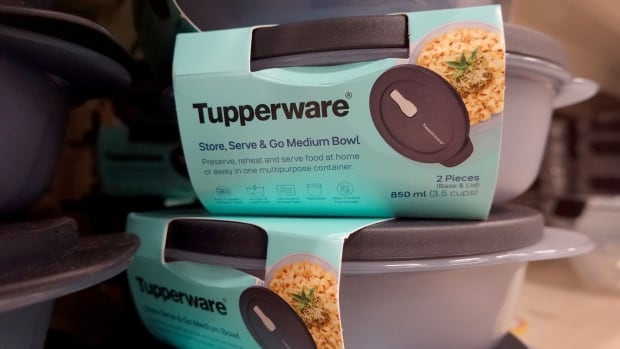
Warning that you might go out of business isn’t the sort of thing that tends to send a company’s stock soaring, but that’s exactly what happened to Tupperware recently.
The company revealed in April that it was in danger of going out of business, with sales slowing just as interest rates on its $700-million US debt load moved in the opposite direction.
The company has had an up and down few years of late, with sales booming in the early days of the COVID-19 pandemic as demand for food storage containers went through the roof — with consumers eschewing restaurants and dining almost exclusively at home amid lockdowns.
As recently as 2021, Tupperware’s shares were changing hands at more than $40 apiece on the New York Stock Exchange. But it’s been a slow and steady decline ever since, as its main business model of selling directly to consumers has fallen out of favour.
By the early part of this year, the company was warning investors about “doubts regarding its ability to continue as a going concern,” sending the stock tumbling to less than $1 a share. In June, the NYSE warned that its shares were in danger of being delisted due to their newfound status as a penny stock.
By the end of that month, Tupperware’s shares were changing hands at barely 61 cents a share. In a filing related to its restructuring process, the company revealed it had signed a waiver with one of its major lenders to buy it time to come up with a solution — which seems to have been the catalyst for a breathtaking turnaround in its fortunes.
Just as they did for GameStop, AMC, BlackBerry and others, small retail investors started pouring money into the company’s shares — taking the price from 64 cents a share on July 19 to $5.70 on Tuesday, for a gain of more than 700 per cent.
Stephen Foerster, a finance professor at Western University’s Ivey Business School in London, Ont., said Tupperware has all the hallmarks of being the latest meme stock.
There’s no hard and fast definition of what one is, but generally they tend to be popular with retail investors who pump up the shares in online communities.
“Meme stocks experience price spikes, huge increase in trading volume, and they trade at a value that appears to be excessive based on traditional valuation metrics,” Foerster said in an interview. “If I go through that list, Tupperware checks all the boxes.”
Tupperware has about 40 million shares, and more than five times in the past two weeks, over 100 million shares have changed hands — meaning the entire company was bought and sold, multiple times over, by investors looking to make a quick buck.
Another ‘short squeeze’
A major hallmark of meme stocks is a heightened level of short-selling activity, which occurs when some investors make money by betting that the price of the stock will go down.
They do this by borrowing shares from existing owners, selling them at the current price, banking on being able to later buy back the shares they borrowed for a cheaper price and pocketing the difference.
An animated explanation of how people make money from stocks losing value
The fee to borrow the shares to short them is up to 140 per cent, according to Fintel, but that hasn’t dampened demand. More than 27 per cent of Tupperware’s shares are currently being shorted, which is an ideal condition for a “short squeeze” — a scenario where rising stock prices force short sellers to buy into the company to cover their losses, causing more and more buying pressure as they do.
Short squeezes were a major factor in dramatic run-ups in stocks like GameStop and AMC a few years ago, and Foerster said it appears to be at play with Tupperware, too.
“They become a battle between, typically, retail investors who have an informal pact between one another to keep buying and not selling, versus professional investors who are … rationally expecting the value of the stock to go down based on fundamentals,” Foerster said.
“Sometimes market participants don’t act rationally. On the other hand, acting rationally, you can also end up getting burned.”
While a short squeeze is clearly afoot, some investors say that’s not all that’s going on. Calum Rodger of Winnipeg, who produces investment content on his YouTube channel Trending Stocks, said despite whatever problems Tupperware has, a stock price below $1 wasn’t justified, so trading in shares to a point where they are now worth more than $200 million is more than warranted.
“Realistically, it still isn’t close to where it should be,” he told CBC News in an interview, noting that before the recent flurry, Tupperware was trading at less than its book value — a metric for measuring a company’s value by tracking what its components are worth from an accounting perspective.
Volatility expected
The company’s revenue growth is slowing and the debt load is a concern, but the underlying business still generates cash flow, Rodger said. “Based on fundamentals like price-to-sales ratio, it should be around $8.”
Rodger said he tends not to trade in stocks experiencing a short squeeze because he doesn’t share that “fight against the power” ethos of teaching Wall Street a lesson that many retail traders tend to have. But he said there are reasons to bid up the company’s shares even without trying to get in on a short squeeze.
“They kind of go hand in hand in this play,” he said. “The shorts have excessively overextended themselves, [so] it’s still a good opportunity to make some good money.”
But Foerster said buying the stock of a company that has warned of its own demise, after an eight-fold increase in the share price, is folly.
“This is a record that has been played over and over and over again. A lot of excitement about a stock, some tremendous, exceptional performance in a short period of time and then eventually — just like the laws of gravity — the stock comes crashing down,” he said.
“This story will not be a happy ending for many investors.”


